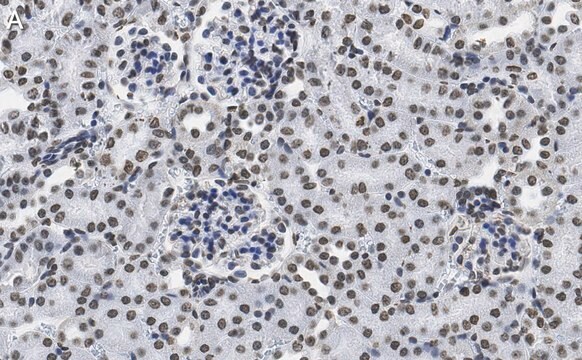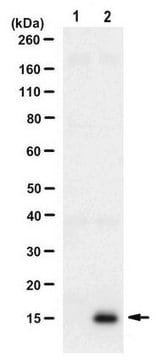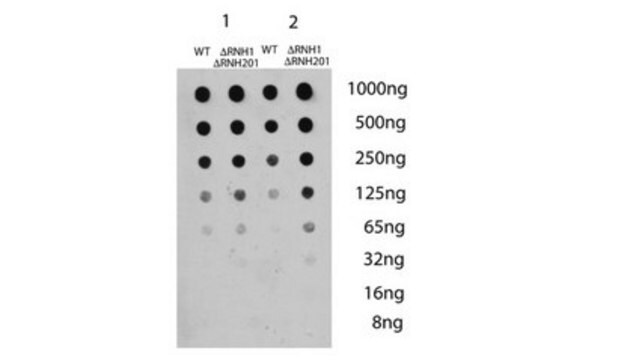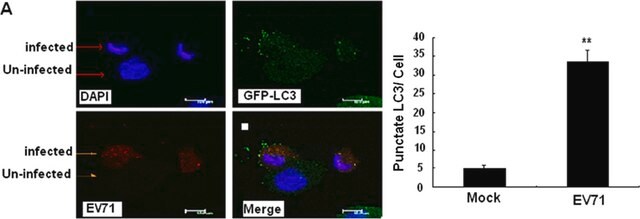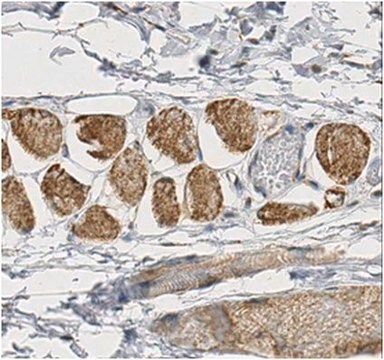MABE1126
Anti-DNA G-quadruplex (G4) Antibody, clone 1H6
clone 1H6, from mouse
Sinônimo(s):
DNA G-quadruplex (G4)
About This Item
Produtos recomendados
fonte biológica
mouse
Nível de qualidade
forma do anticorpo
purified immunoglobulin
tipo de produto de anticorpo
primary antibodies
clone
1H6, monoclonal
reatividade da espécie (prevista por homologia)
all
técnica(s)
ELISA: suitable
flow cytometry: suitable
immunocytochemistry: suitable
immunohistochemistry: suitable (paraffin)
Isotipo
IgG2bκ
Condições de expedição
wet ice
modificação pós-traducional do alvo
unmodified
Descrição geral
Especificidade
Imunogênio
Aplicação
Immunocytochemistry Analysis: A representative lot detected discrete DNA G-quadruplex (G4) foci on the compact chromosome in the metaphase HeLa and murine embryonic stem cells (Henderson, A., et al. (2014). Nucleic Acids Res. 42(2):860-869).
Immunocytochemistry Analysis: A representative lot detected greatly diminished nuclear DNA G-quadruplex (G4) immunoreactivity upon DNase treatment of paraformaldehyde-fixed and Triton X-100-permeablized HeLa cells (Henderson, A., et al. (2014). Nucleic Acids Res. 42(2):860-869).
Immunocytochemistry Analysis: A representative lot detected G-quadruplex (G4) stabilizing agent telomestatin/TMS treatment-induced nuclear DNA G4 immunoreactivity in chicken DT40 cells lacking the G4-unwinding helicase FANCJ, while the drug enhancing effect was not seen in human FANCJ-expressing DT40 cells (Henderson, A., et al. (2014). Nucleic Acids Res. 42(2):860-869).
Immunocytochemistry Analysis: A representative lot detected a time-dependent increase of nuclear DNA G-quadruplex (G4) foci in U20S cells following the treatment of the DNA G4-stabilizing agent telomestatin/TMS (Henderson, A., et al. (2014). Nucleic Acids Res. 42(2):860-869).
ELISA Analysis: Target selectivity of a representative lot was determined by competitive ELISA. Clone 1H6 binds both tetramolecular and unimolecular (intramolecular) DNA G-quadruplex (G4) structures (Henderson, A., et al. (2014). Nucleic Acids Res. 42(2):860-869).
Flow Cytometry Analysis: A representative lot detected enhanced DNA G-quadruplex (G4) immunoreactivity in HeLa cells upon treatment with the DNA G4-stabilizing agent TMPyP4, Cat. No. 613560 (Henderson, A., et al. (2014). Nucleic Acids Res. 42(2):860-869).
Immunohistochemistry Analysis: A representative lot detected nuclear DNA G-quadruplex (G4) immunoreactivity in various paraffin-embedded human tissue sections, including skin, pancreas, testis, placenta, brain, appendix, colon, and kidney (Henderson, A., et al. (2014). Nucleic Acids Res. 42(2):860-869).
Epigenetics & Nuclear Function
Nuclear Receptors
Qualidade
Immunocytochemistry Analysis: 2.0 µg/mL of this antibody detected DNA G-quadruplex (G4) in HeLa cells.
forma física
Armazenamento e estabilidade
Outras notas
Exoneração de responsabilidade
Não está encontrando o produto certo?
Experimente o nosso Ferramenta de seleção de produtos.
recomendado
Código de classe de armazenamento
12 - Non Combustible Liquids
Classe de risco de água (WGK)
WGK 1
Ponto de fulgor (°F)
Not applicable
Ponto de fulgor (°C)
Not applicable
Certificados de análise (COA)
Busque Certificados de análise (COA) digitando o Número do Lote do produto. Os números de lote e remessa podem ser encontrados no rótulo de um produto após a palavra “Lot” ou “Batch”.
Já possui este produto?
Encontre a documentação dos produtos que você adquiriu recentemente na biblioteca de documentos.
Nossa equipe de cientistas tem experiência em todas as áreas de pesquisa, incluindo Life Sciences, ciência de materiais, síntese química, cromatografia, química analítica e muitas outras.
Entre em contato com a assistência técnica
